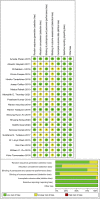Comparison of the efficiency of anti-VEGF drugs intravitreal injections treatment with or without retinal laser photocoagulation for macular edema secondary to retinal vein occlusion: A systematic review and meta-analysis
- PMID: 35935843
- PMCID: PMC9355043
- DOI: 10.3389/fphar.2022.948852
Comparison of the efficiency of anti-VEGF drugs intravitreal injections treatment with or without retinal laser photocoagulation for macular edema secondary to retinal vein occlusion: A systematic review and meta-analysis
Abstract
Objective: To compare the efficiency of anti-VEGF drugs intravitreal injections(IVI) treatment with or without retinal laser photocoagulation(LPC) for macular edema(ME) secondary to retinal vein occlusion(RVO). Methods: The randomized controlled trials and retrospective studies including anti-VEGF drug IVI combined with retinal LPC and single IVI in the treatment of macular edema secondary to RVO were collected in PubMed, Medline, Embase, Cochrane Library, and Web of Science. We extracted the main outcome indicators including the best corrected visual acuity (BCVA), central macular thickness(CMT), the number of injections and the progress of retinal non-perfusion areas(NPAs) for systematic evaluation, to observe whether IVI + LPC could be more effective on the prognosis of RVO. We use Review Manager 5.4 statistical software to analyze the data Results: 527 articles were initially retrieved. We included 20 studies, with a total of 1387 patients who were divided into the combination(IVI + LPC) treatment group and the single IVI group. All the patients completed the ocular examination including BCVA, slit-lamp test, fundus examination and Optical Coherence Tomography(OCT) test before and after each treatment. There was no statistical difference between the combination treatment group and single IVI group on BCVA(WMD = 0.12,95%CI = -3.54-3.78,p = 0.95),CMT(WMD = -4.40,95%CI = -21.33-12.53,p = 0.61) and NPAs(WMD = 0.01,95%CI = -0.28-0.30,p = 0.94).However, the number of IVI was decreased significantly in the combination treatment group in BRVO patients, compared to that in the single IVI group(WMD = -0.69,95%CI = -1.18∼-0.21,p = 0.005). Conclusion: In the treatment of RVO patients with macular edema, the combination of IVI and retinal LPC neither improves BCVA nor reduces CMT significantly compared with the single IVI treatment. However, the combination treatment can decrease the number of intravitreal injections in patients with BRVO, while it is not observed in CRVO patients.
Keywords: anti-VEGF; laser photocoagulation; macular edema; retina vein occlusion; retinal non-perfused areas.
Copyright © 2022 Zou, Du, Ji, Zhang, Ding, Chen, Wang, Ji and Huang.
Conflict of interest statement
The authors declare that the research was conducted in the absence of any commercial or financial relationships that could be construed as a potential conflict of interest.
Figures






Similar articles
-
[Ischemia and laser photocoagulation in retinal vein occlusion].Ophthalmologie. 2022 Nov;119(11):1121-1128. doi: 10.1007/s00347-022-01750-z. Epub 2022 Nov 10. Ophthalmologie. 2022. PMID: 36357589 Review. German.
-
Combination intravitreal anti-vascular endothelial growth factor inhibitors and macular laser photocoagulation relative to intravitreal injection monotherapy in macular oedema secondary to retinal vein occlusion: a meta-analysis of randomized controlled trials.Eye (Lond). 2022 Dec;36(12):2271-2278. doi: 10.1038/s41433-021-01833-2. Epub 2021 Nov 24. Eye (Lond). 2022. PMID: 34819660 Free PMC article.
-
Photocoagulation or sham laser in addition to conventional anti-VEGF therapy in macular edema associated with TelCaps due to diabetic macular edema or retinal vein occlusion (TalaDME): a study protocol for a multicentric, French, two-group, non-commercial, active-control, observer-masked, non-inferiority, randomized controlled clinical trial.Trials. 2024 Apr 22;25(1):273. doi: 10.1186/s13063-024-07994-1. Trials. 2024. PMID: 38649937 Free PMC article.
-
A systematic review and meta-analysis to compare the efficacy of conbercept with ranibizumab in patients with macular edema secondary to retinal vein occlusion.Medicine (Baltimore). 2020 May 22;99(21):e20222. doi: 10.1097/MD.0000000000020222. Medicine (Baltimore). 2020. PMID: 32481293 Free PMC article.
-
Efficacy and effectiveness of anti-VEGF or steroids monotherapy versus combination treatment for macular edema secondary to retinal vein occlusion: a systematic review and meta-analysis.BMC Ophthalmol. 2022 Dec 6;22(1):472. doi: 10.1186/s12886-022-02682-7. BMC Ophthalmol. 2022. PMID: 36474156 Free PMC article.
Cited by
-
Differences between young and elderly polypoidal choroidal vasculopathy patients with and without pachychoroid phenotypes.Graefes Arch Clin Exp Ophthalmol. 2024 Jun;262(6):1765-1776. doi: 10.1007/s00417-023-06361-1. Epub 2024 Jan 17. Graefes Arch Clin Exp Ophthalmol. 2024. PMID: 38231247
-
Systematic review of clinical practice guidelines for the diagnosis and management of retinal vein occlusion.Eye (Lond). 2024 Jun;38(9):1722-1733. doi: 10.1038/s41433-024-03008-1. Epub 2024 Mar 11. Eye (Lond). 2024. PMID: 38467863 Free PMC article.
-
[Ischemia and laser photocoagulation in retinal vein occlusion].Ophthalmologie. 2022 Nov;119(11):1121-1128. doi: 10.1007/s00347-022-01750-z. Epub 2022 Nov 10. Ophthalmologie. 2022. PMID: 36357589 Review. German.
-
Intelligent diagnosis of retinal vein occlusion based on color fundus photographs.Int J Ophthalmol. 2024 Jan 18;17(1):1-6. doi: 10.18240/ijo.2024.01.01. eCollection 2024. Int J Ophthalmol. 2024. PMID: 38239946 Free PMC article.
References
-
- Callizo J., Atili A., Striebe N. A., Bemme S., Feltgen N., Hoerauf H., et al. (2019). Bevacizumab versus bevacizumab and macular grid photocoagulation for macular edema in eyes with non-ischemic branch retinal vein occlusion: Results from a prospective randomized study. Graefes Arch. Clin. Exp. Ophthalmol. 257 (5), 913–920. 10.1007/s00417-018-04223-9 - DOI - PubMed
-
- Cao W., Cui H., Biskup E. (2019). Combination of grid laser photocoagulation and a single intravitreal ranibizumab as an efficient and cost-effective treatment option for macular edema secondary to branch retinal vein occlusion. Rejuvenation Res. 22 (4), 335–341. 10.1089/rej.2018.2141 - DOI - PubMed
Publication types
LinkOut - more resources
Full Text Sources

